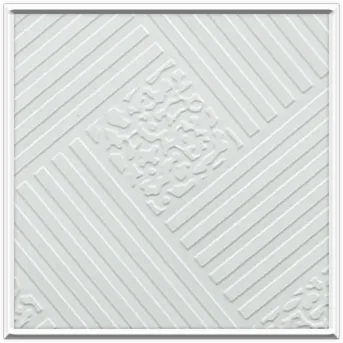- Afrikaans
- Albanian
- Amharic
- Arabic
- Armenian
- Azerbaijani
- Basque
- Belarusian
- Bengali
- Bosnian
- Bulgarian
- Catalan
- Cebuano
- Corsican
- Croatian
- Czech
- Danish
- Dutch
- English
- Esperanto
- Estonian
- French
- German
- Greek
- Hindi
- Indonesian
- irish
- Italian
- Japanese
- Korean
- Lao
- Malay
- Myanmar
- Norwegian
- Norwegian
- Polish
- Portuguese
- Romanian
- Russian
- Serbian
- Spanish
- Swedish
- Thai
- Turkish
- Ukrainian
- Uzbek
- Vietnamese
Dhj . 05, 2024 15:30 Back to list
what is a grid ceiling
What is a Grid Ceiling?
A grid ceiling, also known as a suspended ceiling or drop ceiling, is a modular ceiling system that consists of a framework made of metal or other materials, with tiles or panels that fit into the grid. This type of ceiling is commonly used in commercial buildings, offices, schools, and even residential spaces due to its numerous practical benefits. In this article, we will explore the structure, advantages, applications, and design considerations of grid ceilings.
Structure and Components
At its core, a grid ceiling is designed to hang below the original ceiling, creating a space between the two. The main components of a grid ceiling include
1. Grid System The framework is usually made of lightweight metal, designed to support the ceiling tiles. It consists of T-shaped main runners and cross tees that form a grid. This grid system allows tiles to be easily inserted and removed.
2. Ceiling Tiles These tiles are available in various materials, including mineral fiber, metal, and fiberglass. They come in different textures, colors, and sizes, which provide flexibility in design.
3. Hanging Mechanisms The grid is suspended from the building's structural ceiling using wires or hangers. This creates a void space between the original ceiling and the grid, which can be used for hiding electrical wiring, plumbing, or HVAC systems.
Advantages of Grid Ceilings
Grid ceilings offer several advantages, making them a popular choice for many spaces
1. Easy Installation and Maintenance One of the standout features of grid ceilings is their relative ease of installation compared to traditional ceilings. The modular design means that individual tiles can be easily replaced or removed without significant demolition work. This makes maintenance straightforward as issues like leaks or stains can be quickly addressed.
2. Acoustic Control Certain tiles are designed to enhance sound absorption, which is particularly beneficial in environments where noise reduction is important, such as offices or schools. By controlling noise levels, grid ceilings contribute to a more comfortable atmosphere.
3. Aesthetic Flexibility The variety of available tiles and design options allows for customization to fit various styles and themes. Whether an industrial look or a more polished appearance is desired, grid ceilings can meet those needs.
4. Access to Infrastructure The space between the original ceiling and the grid allows for easy access to plumbing, electrical systems, and HVAC units. This accessibility can be crucial for maintenance, repairs, or adjustments to building systems.
what is a grid ceiling

5. Energy Efficiency Some suspended ceilings include insulation properties that can contribute to a building’s energy efficiency. Proper insulation can help maintain temperature control, reducing heating and cooling costs.
Applications
Grid ceilings are versatile and find applications in various settings
- Commercial Spaces Offices, retail environments, and hospitals often employ grid ceilings due to their functionality and acoustic properties
.- Educational Institutions Schools and universities benefit from these ceilings, particularly for classrooms and lecture halls where noise control is significant.
- Residential Use Homeowners may install grid ceilings in basements, kitchens, or other areas where aesthetics and utility meet.
Design Considerations
While grid ceilings offer many benefits, several design considerations should be taken into account
- Height Regulations Always consider the ceiling height, as suspended ceilings reduce the overall height of a room.
- Lighting Integration Grid ceilings can support various lighting fixtures, but planning for this integration during initial installation is essential.
- Tile Selection Choosing the right tiles for acoustic performance, aesthetics, and fire resistance can greatly impact the ceiling’s effectiveness.
In conclusion, a grid ceiling presents a practical and aesthetically pleasing solution for various spaces, offering advantages in installation, maintenance, and functionality. Whether for commercial or residential use, these ceilings have become a standard in modern architectural design, providing flexibility and versatility for any setting.
-
Transform Interiors with PVC Gypsum Ceiling: A Stylish, Durable, and Moisture-Resistant SolutionNewsMay.19,2025
-
The Smart Interior Upgrade: Discover the Durability and Versatility of Gypsum Ceiling Access Panel SolutionsNewsMay.19,2025
-
The Smart Choice for Interior Design: Discover the Value of PVC Gypsum Ceiling SolutionsNewsMay.19,2025
-
Mineral Fiber Ceiling Tiles: The Smart Blend of Performance and AestheticsNewsMay.19,2025
-
Mineral Fiber Ceiling Tiles: The Superior Choice Over Gypsum for Sound and Fire SafetyNewsMay.19,2025
-
Mineral Fiber Ceiling Tiles: Eco-Friendly Strength and Style for Every CeilingNewsMay.19,2025







